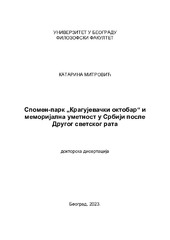Приказ основних података о дисертацији
Спомен-парк ''Крагујевачки октобар'' и меморијална уметност у Србији после Другог светског рата
ˮOctober in Kragujevac“ Memorial Park and memorial art in Serbia after World War Two
| dc.contributor.advisor | Merenik, Lidija | |
| dc.contributor.other | Merenik, Lidija | |
| dc.contributor.other | Manojlović-Pintar, Olga | |
| dc.contributor.other | Ereš, Ana | |
| dc.creator | Mitrović, Katarina | |
| dc.date.accessioned | 2024-03-13T15:48:06Z | |
| dc.date.available | 2024-03-13T15:48:06Z | |
| dc.date.issued | 2023-11-30 | |
| dc.identifier.uri | https://eteze.bg.ac.rs/application/showtheses?thesesId=9554 | |
| dc.identifier.uri | https://fedorabg.bg.ac.rs/fedora/get/o:32978/bdef:Content/download | |
| dc.identifier.uri | https://plus.cobiss.net/cobiss/sr/sr/bib/139115529 | |
| dc.identifier.uri | https://nardus.mpn.gov.rs/handle/123456789/22305 | |
| dc.description.abstract | Стрељање цивила у Крагујевцу 1941. године када је као део нацистичке одмазде за устанак у окупираној Србији убијено скоро три хиљаде људи, постала је једна од најистакнутијих „фигура сећања“ социјалистичке Југославије. Захваљујући континуираном раду на заједничком памћењу коју је спроводила градска власт, „Крагујевачки октобар“ постао је прво неизбежни део митологизоване нарације о Народноослободилачкој борби, да би током шездесетих изашао из оквира југословенске историје и постао један од интернационалних симбола антиратне политике Југославије у блоковској подели света. Спомен-парк „Крагујевачки октобар“ представља један од најмонументалнијих меморијалних комплекса социјалистичке Југославије који се својим значајем, величином и слојевитим садржајем уздиже на ниво вишезначног примера споменичке уметности настале у периоду социјализма (1945- 1990). Начин изградње, морфологија, естетика и идеолошки садржаји спомен-парка у Крагујевцу, као и место које је заузео у идентитетским наративима званичне репрезентативне културе како локалне заједнице (града Крагујевца) тако и СФР Југославије открива дубоку и свепрожимајућу везу између уметничке праксе и теорије с једне, и симболичне политике и идеологије социјалистичке Југославије с друге стране. Споменички комплекс у Крагујевцу укључује све елементе који ће постати карактеристични за модернистичку меморијалну уметност НОБ-а: дизајниран пејзаж са урбанистичком инфраструктуром, споменичку скулптуру, архитектуру, монументалност, узвишеност и модернистички језик уметности као преовлађујући естетско-уметнички модел. Овај меморијал је имао значај удео у животу Крагујевца, као социјалистичког индустријског града, изградњи његовог идентитета, али и истакнути значај у ширем оквиру југословенске симболичне политике. | sr |
| dc.description.abstract | The shooting of civilians in Kragujevac in 1941, when almost three thousand people were killed as part of the Nazi retaliation for the uprising in occupied Serbia, became one of the most prominent „figures of memory“ of socialist Yugoslavia. Thanks to the continuous work on collective memory carried out by the city authorities, the „October in Kragujevac“ first became an inevitable part of the mythologized narrative about the National Liberation Struggle; during the 1960s it exceeded the framework of Yugoslav history and became one of the international symbols of Yugoslavia’s anti-war policy in the bloc division of the world. „October in Kragujevac“ Memorial Park is one of the most grandiose memorial complexes of socialist Yugoslavia, which, with its importance, size and multilayered content, has been lifted to the level of a significant example of monumental art created during the period of socialism (1945–1990). The construction method, morphology, aesthetics and ideological content of the Memorial Park in Kragujevac, as well as the place it occupied in the identity narratives of the official culture of representation of both the local community (the city of Kragujevac) and the SFR Yugoslavia, reveals a deep and all-pervading connection between artistic practice and theory on the one hand, and the symbolic politics and ideology of socialist Yugoslavia on the other. Memorial complex in Kragujevac includes all the elements that have become characteristic of the modernist memorial art of the National Liberation Struggle: a designed landscape with urban infrastructure, monumental sculpture, architecture, monumentality, sublimity and the modernist language of art as the prevailing aestheticartistic model. This memorial had a significant role in the life of Kragujevac, as a socialist industrial city, and in the construction of its identity, as well as a prominent importance in the broader framework of Yugoslav symbolic politics. | en |
| dc.format | application/pdf | |
| dc.language | sr | |
| dc.publisher | Универзитет у Београду, Филозофски факултет | sr |
| dc.rights | openAccess | en |
| dc.source | Универзитет у Београду | sr |
| dc.subject | меморијална уметност, споменици, скулптура, култура сећања, модернизам, социјализам, Крагујевац, спомен парк | sr |
| dc.subject | memorial art, monuments, sculpture, culture of memory, modernism, socialism, Kragujevac, memorial park | en |
| dc.title | Спомен-парк ''Крагујевачки октобар'' и меморијална уметност у Србији после Другог светског рата | sr |
| dc.title.alternative | ˮOctober in Kragujevac“ Memorial Park and memorial art in Serbia after World War Two | en |
| dc.type | doctoralThesis | |
| dc.rights.license | ARR | |
| dc.identifier.fulltext | http://nardus.mpn.gov.rs/bitstream/id/159930/Disertacija_15140.pdf | |
| dc.identifier.fulltext | http://nardus.mpn.gov.rs/bitstream/id/159931/Referat.pdf | |
| dc.identifier.rcub | https://hdl.handle.net/21.15107/rcub_nardus_22305 |



